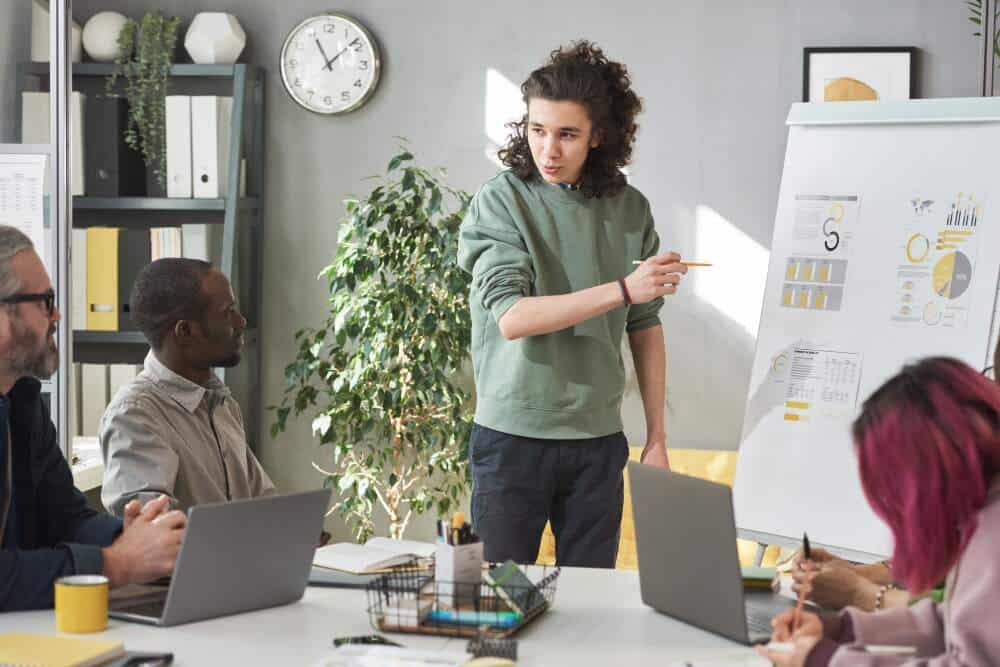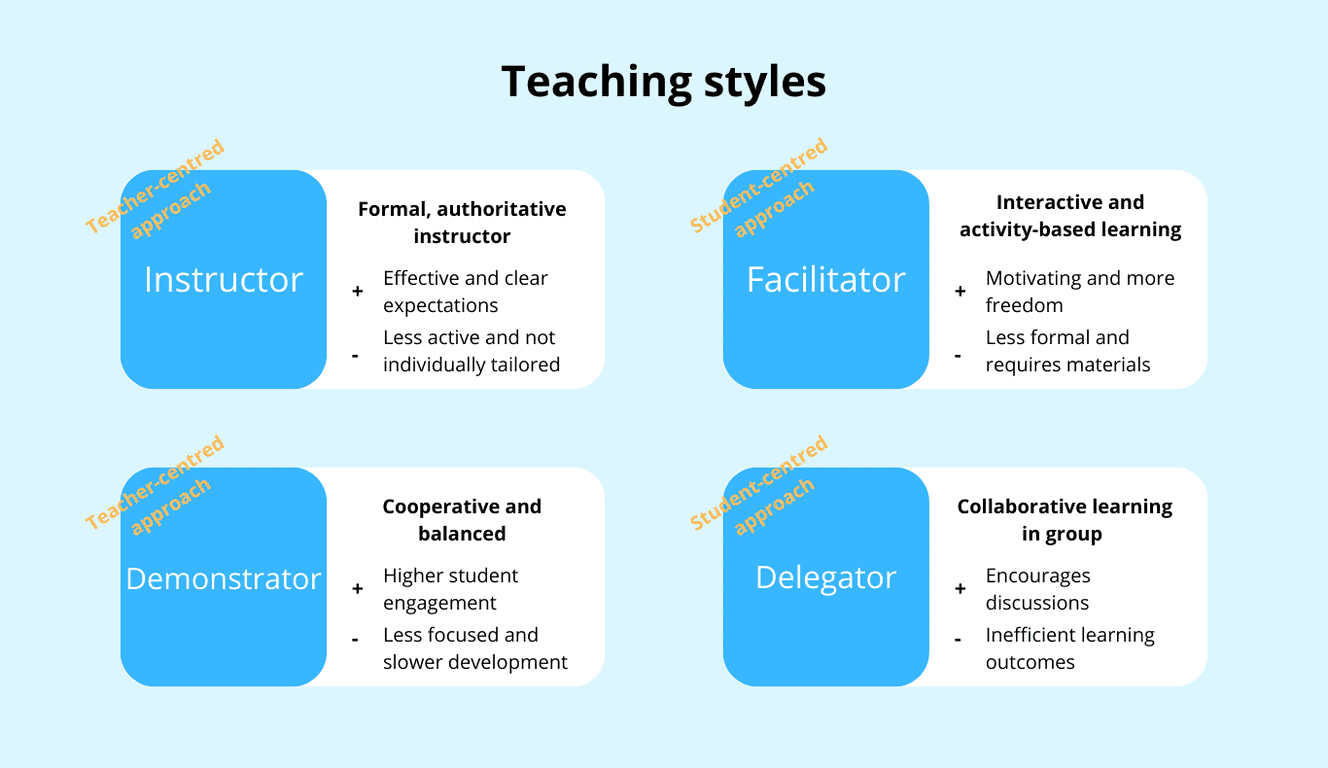Learning is as much about having access to proper learning materials and a proper learning environment as it is about having the correct instructor. We learn differently and we react differently to various teaching styles. That means that the instructor’s approach to teaching affects the learning outcome. Especially in the workplace you are dependent on accessing a teaching style that benefits your professional development, which we will delve into here.

What are teaching styles?
Teaching styles are methods and approaches you use when you are teaching skills and knowledge to students, employees, or course participants. Different teachers or instructors use their preferred tools to transfer their knowledge to other people. These tools or teaching styles range from formal to informal, from authoritative to collaborative, and from active to inactive.
What are the 4 types of teaching styles?
1. Instructor
In this teaching style, there is a central figure who is guiding the learning experience. The instructor is an authoritative figure. You can imagine a lecturer who is giving a lengthy, in-depth lecture on a certain topic. It is characterised by one-way communication and passive learning, where the students take notes and memorise information. It is ideal for larger groups.
Summary of benefits and drawbacks:
- Teacher-centred approach.
- It is easy to provide a clear structure and be time-efficient.
- There is limited student engagement and cannot cater to different learning styles.
2. Demonstrator
The instructor combines teaching and learning forms, including demonstrations, multimedia use and activities. The instructor is still authoritative, but is not relying solely on verbal teaching or giving instructions. Instead, they are presenting materials and asking engaging questions to start discussions.
Summary of benefits and drawbacks:
- Teacher-centred approach.
- Different teaching formats which provide hands-on learning opportunities.
- Is not suited for all learners or all topics, and can be quite time-consuming
3. Facilitator
The facilitator learning style is an interactive and activity-based learning, where the instructor is focused on asking students questions and encouraging them to find the answers through discussions. The instructor is not authoritative and is instead facilitating discussions. Many believe that this kind of problem-solving will give a deeper understanding of the topic.
Summary of benefits and drawbacks:
- Student-centred approach.
- Fosters critical thinking and communication skills.
- It requires a competent instructor who provides support when needed.
4. Delegator
This is a collaborative teaching style, meaning that the learning happens in groups. The instructor takes the role of a delegator who observes the groups and helps to promote collaboration between students. They encourage peer feedback and peer-to-peer learning, which removes the instructor from a position of authority.
Summary of benefits and drawbacks:
- Student-centric approach.
- Teaching style which encourages individual learning experiences and problem-solving among students.
- Can be inefficient and not suitable for all learners.
You need to balance instructing and facilitating learning through teaching.
What are teaching approaches?
You might have noticed that we have divided the teaching styles into teacher-centred or student-centred approaches. These two approaches have a different focus in the teaching and learning, where the student or instructor are centred in the teaching materials and activities.
Two different approaches to teaching and learning
Teacher-centred approach
The teacher-centred approach is characterised by authority. The instructor is given the role of authority, who gives instructions and determines how the teaching will be structured. Therefore, the instructor decides which learning materials, formats and activities are best suited for the groups of students. This gives the instructor the power to decide what form of learning the student will benefit from.
- Instructor and demonstrator teaching styles are examples of the teacher-centred approach.
Student-centred approach
As opposed to the teacher-centred approach, the student-approach is less formal and more interactive. The authoritative figure is removed from the equation and the learners are in focus. They take the helm of the learning sessions, which are tailored to their needs and how they learn the best.
- Facilitator and delegator teaching styles are examples of the student-centred approach.
How do I adapt the correct teaching method in my online course?
If you want to engage your participants and make sure that you retain them, you need to consider which teaching style will resonate with them. Some learn the best from a lecture-style session, where the instructor tells them exactly what they should know, while others prefer more autonomy and peer-to-peer discussions.
Let us say you are in charge of upskilling at your workplace and you want to produce an online course for them to gain some knowledge into how to make marketing strategies from scratch. Then you should consider how you want to explain this. Do you want interactive elements, where the new hires can discuss amongst themselves? A good idea is to produce videos that demonstrate how a marketing strategy works. You should also consider making an online community where they can discuss assignments.
Check out the examples of teaching styles below that can inspire you when you are producing content for your online course.
Teaching styles examples
Lecturing
This is ideal for bigger groups where you want to cover much material quickly. However, it does not require active learning or participation from the students.
Demonstrating
This teaching style is perfect for online classes, where you can include videos and multimedia tools that demonstrate how something is done. Additionally, you can link the lecture or session to an online community where students can participate and discuss assignments.
Hybrid
A hybrid teaching style combines student-centred and teacher-centred approaches, which balances the structure of a lecture-style teaching environment with collaborative and social activities to increase engagement.
Read also: How to create an online course
The teaching style affects the learning outcome.
Different teaching methods
Experiential learning
Learning is a product of experience and by putting yourself in a situation where you learn socially or from experiences you have not had before. Experiential learning encourages creativity, fosters reflective thinking and prepares learners for future experiences.
Especially in the workplace, experiential learning is a great tool for new hires to gain the necessary knowledge and skills to perform well in their new role. They can observe colleagues and get experiences from following along with them for a day. At the same time, experiential learning often happens without the learner even recognising it. When doing something they have not done before, they remember this and put it into action in a future, similar situation.
Explore further: The importance of a learning culture
Online learning
The online format is a flexible form of teaching and learning, where both the instructor and learner have the freedom to choose how and when they teach and learn the best. Whether you are an instructor or a professional course provider, online learning enables you to design a course structure that is less dependent on a physical classroom and strict timetables. By doing that, course participants, employees or students can do the course whenever and wherever they want, directly from their computer or smartphone.
Continue reading: The benefits of online learning
Blended learning
Blended learning offers the ideal combination of the traditional classroom teaching style and online learning. It can be structured around a fixed schedule, where some days have physical attendance and on other days it relies solely on digital tools. In other models, there can be a combination of both tools in one day. This makes it easier to customise the training sessions and gives more flexibility to the learners.
Read: Blended learning in practice as a course provider
Bite-sized learning
People learn differently and react differently to various teaching styles. No matter the teaching style, you can implement bite-sized learning tools to accommodate people who learn at different speeds. It involves breaking down complex information into smaller, easily digestible pieces. This approach allows learners to absorb and retain information more effectively.
Read: A guide to bite-sized learning
Put your teaching style to test with a LMS
If you work with upskilling internally in your organisation, you can engage a professional course provider or organise your own upskilling training sessions. For the latter, you can use a learning management system (LMS). You can use the FrontCore LMS to simplify and boost e-learning efforts. This is a tool you can use for in-house training, which allows you to build online courses that can be organised however you like.
For training or courses you can use the training management system (TMS) to administrate courses and integrate it with LMS to facilitate online and physical-based courses.
Did you like this article? Don't forget to share it:








0 Comments